- Home
- Stephen E. Ambrose
The Men of World War II Page 25
The Men of World War II Read online
Page 25
Lipton and Popeye Wynn looked at the place where the sniper had held them up, the one Powers shot at. They found the sniper with a bullet right in the middle of the forehead.
“You know,” Wynn commented, “it just doesn’t pay to be shootin’ at Shifty when he’s got a rifle.”
• • •
It was early afternoon. A movie camera team moved in to take film of the victory. Back on the ridge line at the edge of the woods, Winters noticed two photographers taking pictures of the stretcher bearers bringing in the wounded from 1st platoon. “When the detail reached about 25 yards from the woods, well out of danger, one photographer put down his camera and dashed out to grab hold of the soldier to help carry him. He grabbed him in such a way that he got as much blood on the sleeve and front of his nice new, clean, heavily fleeced jacket as possible. Then this guy turned toward his buddy, who was still taking pictures, and put on a big act of being utterly exhausted as he struggled across those final few yards to the woods. At that point he immediately dropped out.”
That evening, Colonel Sink called for a meeting at regimental HQ for all the principal parties involved in the attack. Sink opened with a question for Winters: “What are you going to do about Company E?”
“Relieve Lieutenant Dike and put Lieutenant Speirs in command,” Winters replied.
Sink agreed with the decision, and the meeting ended. Lieutenant Foley also agreed. He wrote, “We were glad to see Dike leave, not only because he failed the 1st platoon but even back in the woods when the 2d platoon was hit with those tree bursts, it was evident that ‘Foxhole Norman’ wasn’t meant to be our C.O.”
It quickly became clear that Speirs was; indeed, he had already demonstrated that, in the rush on Foy.
* * *
1. Quoted in John Keegan, The Face of Battle, (New York: Penguin Books, 1976), 335–36.
2. Standing on the spot in 1991 with Winters, Lipton, and Malarkey, when Winters indicated that he had set up one machine-gun just there, pointing at my wife Moira’s feet, she looked down, bent over, and picked up a 30-caliber shell casing to hand to him. (The field had recently been plowed.)
3. Keegan, The Face of Battle, 16.
13
Attack
NOVILLE
January 14–17, 1945
“WHEN WORD CAME DOWN for this attack, it pissed me off,” Winters remembered. “I could not believe that after what we had gone through and done, after all the casualties we had suffered, they were putting us into an attack. It just had the flavor of an ego trip for General Taylor, a play to show Eisenhower that now that Taylor’s back his troops will get off their asses and go into the attack.”
That is not fair to General Taylor. The attack was part of a general offensive designed to cut through to the north and link up with the U.S. First Army, thereby trapping the German tanks in the tip of the salient. Or as many as were left, after Monty’s shilly-shallying about getting going on the counteroffensive. The Germans had begun to pull their tanks back. They could be expected to fight with all they had to keep that escape route open.
As to putting a company as badly mauled as Easy into a frontal attack over a snowfield in bright daylight, this didn’t come about because Taylor wanted glory but because Eisenhower needed men. He had no reserves available to throw into the attack, this was the moment to attack, he had to attack with what was there on the front lines. In other words, Easy was paying the price for the policy of limited mobilization. There simply were not enough troops for the job.
• • •
After Foy fell, Easy and the other companies in 2d Battalion were put into regimental reserve, south of the village. At 0415 the following day, January 14, the Germans launched a counterattack on Foy with six tanks and a company of infantry. It was repulsed, but then another attack with fourteen tanks and a battalion forced the 3d Battalion of the 506th out of Foy. Easy was alerted, but with the help of artillery the 3d Battalion was able to mount its own successful counterattack and by 0930 was back in the village.
These actions were carried out under horrid conditions. Another cold front had passed through the area. Daytime temperatures were about 20 degrees F; at night the mercury plunged to below zero. There was almost daily snow. It was difficult for Division to move supplies up the Bastogne-Foy road because of drifts and demands elsewhere. As a result, the men of Easy were almost as badly off as during the first week of the siege. There was not enough food. There were insufficient over-shoes, blankets, and sleeping bags. Bed sheets were used for snow suits.
The terrain in front of Easy was also difficult. There was open ground to cross to get to Noville, dense woods still to be cleared. The Germans held the high ground and the solid Belgian buildings in Noville offered sniper and machine-gun positions while providing the Germans with hiding places for tanks.
Colonel Sink told Winters that 2d Battalion would have the honor of leading the attack on Noville. He would jump off at 1200, January 14, moving from the woods south of Foy around to the left (west), occupy the tiny village of Recogne, then attack over an open, snow-covered field toward Cobru, another tiny village a kilometer or so east of Noville. On Winters’s left, 1st Battalion would move north through the woods to clear them out.
Winters was unhappy with the orders. He had 2 kilometers of snow-covered open fields to cross to get to Cobru. It was a bright sunny day. Why attack at high noon? Winters would have preferred to wait through the night, then set out at first light to cross the field. But Eisenhower wanted action, Monty wanted action, Taylor wanted action, Sink wanted action, so 2d Battalion’s HQ, Dog, Easy, and Fox Companies would have to provide it.
There was a fairly deep shoulder running southwest out of Noville to near Recogne. Winters saw that by sending his men straight for it, he could pick up more and more cover as they got closer to Noville. He put the battalion in single file to cut through the snow, dangerous but quick.
As Easy and the rest of 2d Battalion moved out, so did the 1st Battalion on the left. German tanks in Noville got 1st Battalion in their sights and let loose with some 88s. They did not see 2d Battalion marching toward Noville in the shelter of that shoulder.
Winters glanced to his left. The 88s were tearing up the 1st Battalion. “Men were flying through the air,” Winters recalled. “Years later, in the movie Doctor Zhivago, I saw troops crossing snow-covered fields, being shot into by cannon from the edge of the woods, and men flying through the air. Those scenes seemed very real to me.”
Easy was having its own problems. German machine-guns in Noville opened on the company, at a draw and stream that slowed the Americans while they were exposed. Speirs set up two of his machine-guns to answer the fire. As the American machine-gunners let loose with a burst, a group of eight or ten would dash across the small stream.
The stream was narrow enough for most of the men to jump across. But Pvt. Tony Garcia, carrying an ammo bag with six rounds of mortar ammunition, fell into the stream. He was soaked. By the time his group reached Noville, “my clothing had frozen, causing a crackling sound as I walked. This, however, saved me from going on an all-night patrol which was to have made contact with one of our own units. The platoon sergeant said I could be heard all the way to Berlin and for me to stay put.”1
By 1530 2d Battalion had crossed the field and was snuggled up to the underside of the shoulder. By dark it had worked its way around to a draw on the southeast corner of Cobru.
Speirs held a meeting of the officers and 1st Sergeant Lipton. He outlined the plan of attack for the morning, up the draw to Noville, with 2d platoon on the left, 3d on the right. Friendly tanks were supposed to be coming up on the right in support on the Foy-Noville road. After the meeting Speirs told Lipton to lead the 2d platoon in the attack.
Lipton pulled 2d platoon together to brief the men. Winters stood to the side, listening. Lipton told them the distance to the town was about 800 meters, that they should move quickly to get down the road and into the shelter of the buildings, that th
ey should clear out the buildings working together as teams with rifles and grenades, that the mortar men should be ready to drop rounds on German strong points, that the machine-gunners should set up and lay down a base of fire in support, that they should not bunch up, and so on. Winters’s sole comment was that the distance was more like 1,000 meters.
As the meeting broke up, the men could hear tank motors starting up and tanks moving around. It was not possible to determine if it was Germans pulling out or Americans coming along the Foy-Noville road.
Winters remembers the night as the coldest of his life. There was little shelter, only hastily dug foxholes. The men had worked up a sweat getting to Cobru. They shivered through the night. They would lie down and drift off, only to be awakened by intense shivering in their now-frozen clothes. Most gave up on trying to sleep. It got so bad that at one point Winters though about ordering a night attack, but decided against it because of the danger of shooting each other in the confusion.
Lipton was uneasy about leading 2d platoon on an attack without knowing what was up ahead, so he decided to go forward with a radio man to scout the situation in Noville. The two men came to a barn on the outskirts of the village, entered it by a door in the back and felt their way through to a door that opened into a courtyard near the main road through Noville. Everything was quiet. Lipton called Speirs on the radio to tell the C.O. where he was and to request permission to scout the town. He said he could see some Sherman tanks up ahead and asked if Speirs knew if American armor had already taken the town. Speirs did not know and told Lipton to look around.
Lipton moved silently forward to the tanks. They were knocked out. American bodies lay frozen and strewn around them. They had been left there when Team Desobry had withdrawn from Noville on December 20, almost a month earlier. The Germans still held the town. Lipton and his radio man withdrew.
• • •
The attack jumped off at dawn, January 15. There was resistance, strongest on the right hand side of the road against 3d platoon. The 2d platoon quickly got into the center of Noville and up to the burned-out Shermans. The 3d platoon got into a burned-out building and set up a CP. Over the radio came a message, “Friendly armor on the right.”
As Lieutenant Shames and Sergeant Alley got that message, they heard tanks outside the building. Anxious to get the show on the road, Alley told Shames he was going to link up with those tanks. Shames decided to join him. They moved by several burned-out buildings and rounded a corner into the main road. Up ahead, between two buildings, partway out, was the tank they sought.
Alley moved up to the side of the tank. The tank commander was standing in the turret looking the other way, so Alley shouted to him over the roar of the engine to “Come this way.” The tank commander turned, and Alley realized he had mistaken a German tank for an American. The German swore, dropped into his tank, and began traversing his turret toward Alley and Shames.
They said not a word to each other. They took off so fast they were kicking snow in the German’s face. The tank followed. The Americans ran around a corner. Shames saw an open window and dived in head first. Alley ran 3 meters or so past him and jumped into a doorway with his rifle ready for the infantry he was sure would be with the German tank.
The tank turned the corner and drove right past Shames and Alley. It came to the place where 2d platoon was clearing out buildings, near the burned-out Shermans. Lipton and his men dived under the Shermans or ducked behind walls for protection. The German tank stopped and, swiveling its turret, put a shell into each one of the knocked-out Shermans to prevent anyone from using their guns to put a shell into his tank as he drove past. Lipton recalled, “When those shells hit the Shermans, it felt to us under them that they jumped a foot in the air.”
The tank roared out of town, headed north toward safety. A P-47 fighter plane spotted it, strafed it, and dropped a bomb on it, destroying the tank.
Alley went to look for Shames. He heard moaning and cries for help. When he got to the window Shames had dived through, he looked and burst into laughter. He saw his lieutenant tangled up in bedsteads, springs, and furniture in a basement Shames had not realized was there.
By noon, 2d Battalion held Noville and had set up a perimeter defense. The little village and its surrounding hills had been an objective of the 101st since December 20. Finally it was in American hands.
• • •
“We had looked northward at Noville from our positions outside Foy since shortly after we had arrived at Bastogne,” Lipton wrote, “and we had convinced ourselves it would be our final objective in the Bastogne campaign.” But there was one more attack to make; General Taylor wanted 2d Battalion to move farther north, in the direction of Houffalize, to clear the village of Rachamps.
Rachamps was off the highway, over to the right (east). It was in a valley. The snow-covered ground sloped gently down to it from all sides, giving an effect similar to attacking from the rim of a saucer toward its center. The 2d Battalion attacked from the south and southwest, while 1st Battalion on the left came down from north of the village. The men were well-spread and advanced steadily. The Germans put up some resistance, mainly artillery using white phosphorus shells. But as the men of the 506th got to the outskirts of the village, most of the German defenders fled. As the Americans moved in, the Germans began bombarding the village.
Sgt. Earl Hale was one of the first into Rachamps. He and Liebgott ducked into a barn, where they surprised and made prisoner six SS officers. Hale lined them up nose to nose and told them that if he and Liebgott got killed they were going to take the Germans with them. Hale covered them with his tommy-gun to make the point.
A shell exploded outside. Hale was standing by the door. He got hit by a piece of shrapnel and went down. An SS officer pulled his knife from his boot and slashed Hale’s throat. He failed to cut an artery or sever the windpipe, but did cut the esophagus. Blood gushed out. Liebgott shot the officer who did the cutting, then the others. Medic Roe got sulfa powder on Hale’s wound. A jeep evacuated him to Luxembourg, where an amazed doctor patched him up, leaving a crooked esophagus. Because of Hale’s condition, the doctor gave him a medical order stating that he did not have to wear a necktie. (Later, Hale was stopped by an irate General Patton who chewed him out for not wearing his necktie. Hale triumphantly produced his slip of paper, leaving Patton for once speechless.)
• • •
The easy victory at Rachamps showed how completely the 101st Airborne had won its head-to-head battles with a dozen crack German armored and infantry divisions. The Americans had gone through a much more miserable month than the Germans, who had an open and bountiful supply line. For the 101st, surrounded, there were no supplies in the first week and insufficient supplies thereafter. Those were the weeks that tried the souls of men who were inadequately fed, clothed, and armed. This was war at its harshest, horrible to experience. The 101st, hungry, cold, underarmed, fought the finest units Nazi Germany could produce at this stage of the war. Those Wehrmacht and SS troops were well fed, warm, and fully armed, and they heavily outnumbered the 101st.
It was a test of arms, will, and national systems, matching the best the Nazis had against the best the Americans had, with all the advantages on the German side. The 101st not only endured, it prevailed. It is an epic tale as much for what it revealed as what happened. The defeat of the Germans in their biggest offensive in the West in World War II, and the turning of that defeat into a major opportunity “to kill Germans west of the Rhine,” as Eisenhower put it, was a superb feat of arms. The Americans established a moral superiority over the Germans. It was based not on equipment or quantity of arms, but on teamwork, coordination, leadership, and mutual trust in a line that ran straight from Ike’s HQ right on down to E Company. The Germans had little in the way of such qualities. The moral superiority was based on better training methods, better selection methods for command positions, ultimately on a more open army reflecting a more open society. Democracy proved better a
ble to produce young men who could be made into superb soldiers than Nazi Germany.
What veterans of far-flung campaigns these German soldiers were was revealed in a little incident in Rachamps. Sergeant Rader related it: “I almost killed a Kraut prisoner for laughing at me after I got to the town, only to have someone grab my M-1 and shout, ‘Sarge, he has no lips or eyelids!’ He had lost them on the Russian front, frozen off.”
The battle made the 101st into a legend. The legend that began in Normandy and grew in Holland reached its climax in Bastogne. The 101st Airborne was the most famous and admired of all the eighty-nine divisions the United States Army put into the Second World War. Ever since, men have worn that Screaming Eagle on their left shoulders with the greatest of pride.
• • •
In Rachamps, Speirs set up company CP in a convent. It was the first time the CP had been in a building since Easy left Mourmelon a month earlier. That night the nuns brought into the large hall of the convent a group of twelve- and thirteen-year-old girls to sing a serenade for E Company. The program included French and Belgian songs, several in English, and the German marching song, “Lili Marlene.”
The next morning, January 17, the 17th Airborne Division relieved the 101st on the line. Easy Company got into trucks to begin a move to Alsace. The trucks took the men back down the highway they had sat astride for four weeks, through Bastogne. It was only the second time most of the men had seen Bastogne—first on December 19 when they marched through the town while frightened American soldiers fled to escape the German onslaught, second on January 17, the town secured.
Although the men had seen little of Bastogne, that name—and the experience it represented—would stay with them forever. Whenever thereafter a man from Easy experienced cold or hunger or sleep deprivation, he would remind himself of Bastogne and recall that he had been through much worse.

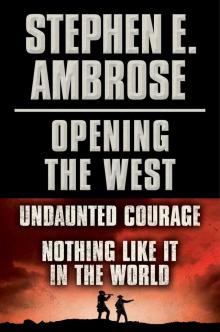 Undaunted Courage
Undaunted Courage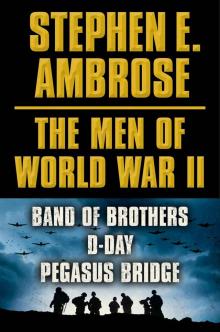 The Victors: Eisenhower and His Boys
The Victors: Eisenhower and His Boys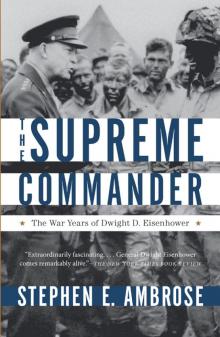 The Supreme Commander
The Supreme Commander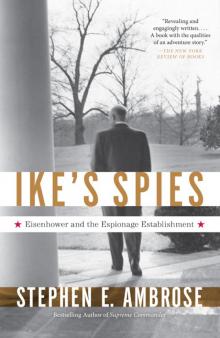 Ike's Spies: Eisenhower and the Espionage Establishment
Ike's Spies: Eisenhower and the Espionage Establishment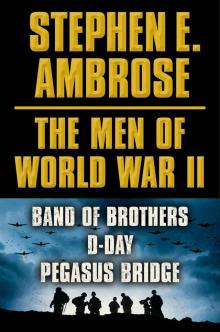 The Men of World War II
The Men of World War II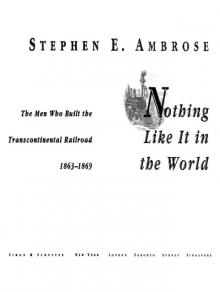 Nothing Like It in the World The Men Who Built the Transcontinental Railroad 1863-1869
Nothing Like It in the World The Men Who Built the Transcontinental Railroad 1863-1869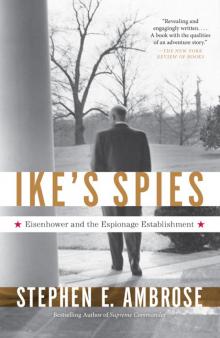 Ike's Spies
Ike's Spies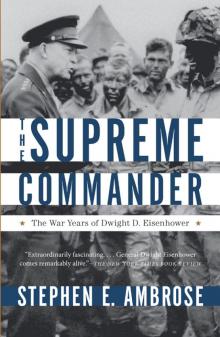 Supreme Commander
Supreme Commander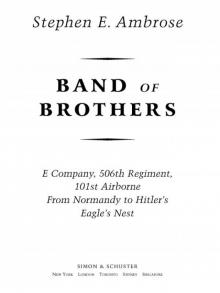 Band of Brothers
Band of Brothers